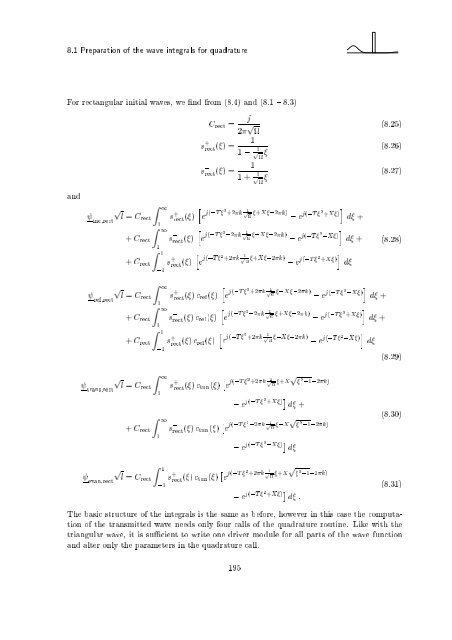Wave Propagation in Linear Media | re-examined
Wave Propagation in Linear Media | re-examined
Wave Propagation in Linear Media | re-examined
You also want an ePaper? Increase the reach of your titles
YUMPU automatically turns print PDFs into web optimized ePapers that Google loves.
8.1 P<strong>re</strong>paration of the wave <strong>in</strong>tegrals for quadratu<strong>re</strong><br />
For <strong>re</strong>ctangular <strong>in</strong>itial waves, we nd from (8.4) and (8.1 { 8.3)<br />
and<br />
<strong>in</strong>c,<strong>re</strong>ct<br />
<strong>re</strong>f,<strong>re</strong>ct<br />
trans,<strong>re</strong>ct<br />
evan,<strong>re</strong>ct<br />
p l = C<strong>re</strong>ct<br />
+ C<strong>re</strong>ct<br />
+ C<strong>re</strong>ct<br />
p l = C<strong>re</strong>ct<br />
+ C<strong>re</strong>ct<br />
+ C<strong>re</strong>ct<br />
p l = C<strong>re</strong>ct<br />
+ C<strong>re</strong>ct<br />
p l = C<strong>re</strong>ct<br />
Z 1<br />
1 Z 1<br />
1 Z 1<br />
,1<br />
Z 1<br />
1 Z 1<br />
1 Z 1<br />
,1<br />
Z 1<br />
1<br />
Z 1<br />
1<br />
Z 1<br />
,1<br />
C<strong>re</strong>ct =<br />
j<br />
p<br />
2<br />
(8.25)<br />
s +<br />
1<br />
<strong>re</strong>ct ( )=<br />
1, 1 p<br />
(8.26)<br />
s , <strong>re</strong>ct ( )=<br />
1<br />
1+ 1<br />
p<br />
s +<br />
h j(,T<br />
<strong>re</strong>ct ( ) e 2 +2 k 1 p +X ,2 k) j(,T<br />
, e 2 i<br />
+X )<br />
d +<br />
s , <strong>re</strong>ct ( )<br />
s +<br />
<strong>re</strong>ct ( )<br />
h j(,T<br />
e 2 ,2 k 1<br />
p ,X ,2 k) j(,T<br />
, e 2 i<br />
,X )<br />
d +<br />
h j(,T<br />
e 2 +2 k 1<br />
p +X ,2 k) j(,T<br />
, e 2 i<br />
+X )<br />
d<br />
s +<br />
<strong>re</strong>ct ( ) c h j(,T<br />
<strong>re</strong>f( ) e 2 +2 k 1 p ,X ,2 k) j(,T<br />
, e 2 i<br />
,X )<br />
d +<br />
h j(,T<br />
e 2 ,2 k 1 p +X ,2 k) j(,T<br />
, e 2 i<br />
+X )<br />
d +<br />
s , <strong>re</strong>ct ( ) c <strong>re</strong>f( )<br />
s +<br />
<strong>re</strong>ct ( ) c <strong>re</strong>f( )<br />
h j(,T<br />
e 2 +2 k 1<br />
p ,X ,2 k) j(,T<br />
, e 2 i<br />
,X )<br />
d<br />
s +<br />
<strong>re</strong>ct ( ) ctun( ) e j(,T 2 +2 k 1<br />
p<br />
p +X 2,1,2 k)<br />
, e j(,T 2 +X ) d +<br />
s , <strong>re</strong>ct ( ) ctun( ) e j(,T 2 ,2 k 1<br />
p<br />
p ,X 2,1,2 k)<br />
, e j(,T 2 ,X ) d<br />
s +<br />
<strong>re</strong>ct ( ) ctun( ) e j(,T 2 +2 k 1<br />
p<br />
p +X 2,1,2 k)<br />
, e j(,T 2 +X ) d :<br />
(8.27)<br />
(8.28)<br />
(8.29)<br />
(8.30)<br />
(8.31)<br />
The basic structu<strong>re</strong> of the <strong>in</strong>tegrals is the same as befo<strong>re</strong>, however <strong>in</strong> this case the computation<br />
of the transmitted wave needs only four calls of the quadratu<strong>re</strong> rout<strong>in</strong>e. Like with the<br />
triangular wave, it is su cient towrite one driver module for all parts of the wave function<br />
and alter only the parameters <strong>in</strong> the quadratu<strong>re</strong> call.<br />
195












